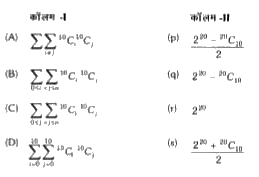यदि I1=∫102x2dx,I2=∫102x3dx,I3=∫212x2dx और I4=∫212x3dx, तब
I3=I4
I3>I4
I2>I1
I1>I2
The correct Answer is:D
Step by step video, text & image solution for यदि I_(1) = int_(0)^(1)2^(x^2)dx, I_(2) = int_(0)^(1)2^(x^3)dx, I_(3) = int_(1)^(2)2^(x^2)dx और I_(4)= int_(1)^(2) 2^(x^3)dx, तब by Maths experts to help you in doubts & scoring excellent marks in Class 12 exams.
Updated on:21/07/2023Topper's Solved these Questions
- निश्चित समाकलन एवं वक्रों से घिरा क्षेत्रफल Book:ERRORLESS HINDIChapter:निश्चित समाकलन एवं वक्रों से घिरा क्षेत्रफल Exercise:JEE ADVANCED (More than one correct answers)
Explore 24 Videos
- निश्चित समाकलन एवं वक्रों से घिरा क्षेत्रफल Book:ERRORLESS HINDIChapter:निश्चित समाकलन एवं वक्रों से घिरा क्षेत्रफल Exercise:JEE ADVANCED (Reasoning type questions)
Explore 8 Videos
- निश्चित समाकलन एवं वक्रों से घिरा क्षेत्रफल Book:ERRORLESS HINDIChapter:निश्चित समाकलन एवं वक्रों से घिरा क्षेत्रफल Exercise:SOLVED MULTIPLE CHOICE QUESTIONS (वक्रों द्वारा परिबद्ध क्षेत्रफल )
Explore 97 Videos
- द्विपद प्रमेय तथा गणितीय आगमन Book:ERRORLESS HINDIChapter:द्विपद प्रमेय तथा गणितीय आगमन Exercise:JEE Advanced (Matrix Math type questions)
Explore 5 Videos
- प्रायिकताBook:ERRORLESS HINDIChapter:प्रायिकताExercise:EXERCISE
Explore 99 Videos
Similar Questions
यदि In=∫π−πsinnx(1+πx)sinxdx , n = 0 , 1, 2 ..........., तब
View Solutionकथन-1 : समाकलन ∫π/3π/6dx1+√tanx का मान π/6 है
कथन-2 : ∫baf(x)dx=∫baf(a+b−x)dx
View Solutionवक्र y=xex2 , x- अक्ष तथा कोटियों x = 0, x = a से घिरा क्षेत्रफल है
View Solutionनिम्नलिखित कॉलम I को कॉलम II से मिलाये

View SolutionA, B, C तीन परस्पर स्वतंत्र घटनायें हैं। S1 तथा S2 दो कथनों को देखने पर
S1 : A तथा B∪C स्वतन्त्र हैं
S2 : A तथा B∩C स्वतन्त्र हैं तब
View SolutionI1=∫π20sinx−cosx1+sinxcosxdx,I2=∫2π0cos6xdx,I3=∫π2π2sin3xdx,I4=∫101n(1x−1)dx.Then I2=I3=I4=0,I1≠0 I1=I2=I3=0,I4≠0 I1=I2=I3=0,I4≠0 I1=I2=I3=0,I4≠0
View SolutionIfI1=∫102x2,I2=∫102x3dx,I3=∫212x2dx,I4=∫212x3dx, then which of the following is/are true? I1>I2 (b) I2>I1 I3>I4 (d) I3<I4
View SolutionIf I_(1)=int_(0)^(3 pi)f(cos^(2)x)dx and I_(2)=int_(0)^( pi)f(cos^(2)x)dx then (a)I_(1)=I_(2)(2)I_(1)=2I_(2)(3)I_(1)=5I_(2)(4)I_(1)=3I_(2)
View SolutionIf i is the greatest of the definite integrals I_(1)=int_(0)^(1)e^(-x)cos^(2)dx,I_(2)=int_(0)^(1)e^(-x^(2))cos^(2)xdx and I_(3)=int_(0)e^(-x^(2))dx,I_(4)=int_(0)^(1)e^(-((x^(2))/(2)))dx then (A)I_(1)(B)I_(2)(C)I_(3)(D)I_(4)
View Solutionl_(1)=int_(0)^(1)3^(x^(2))dx,l_(2)=int_(0)^(1)3^(x^(3))dx,l_(3)=int_(1)^(2)3^(x^(2))dx,l_(4)=int_(1)^(2)3^(x^(3))dx then (i)I_(1)>I_(2)(ii)I_(2)>I_(1)(iii)I_(3)>I_(4)(iv)I_(4)>I_(3)
View SolutionI1=∫π20sinx−cosx1+sinxcosxdx,I2=∫2π0cos6dx,
I3=∫π2−π2sin3xdx,I4=∫10In(1x−1)dx. Then
View SolutionLet I1=∫211√1+x2dx and I2=∫211xdx.Then
View SolutionIf I1=∫102x2dx,I2=∫102x3dx,I3=∫212x2dx
and I4=∫212x2dx then
View SolutionIf I1=∫π20(sinx)√3+1dx,I2=∫π20(sinx)√3−1)dx then I1I2=
View SolutionIf I1=∫102x2dx,I2=∫102x3dx, I3=∫212x2dx,I4=∫212x3dx then
View Solution